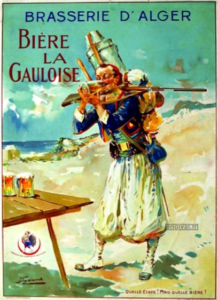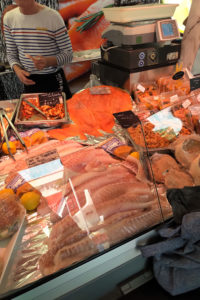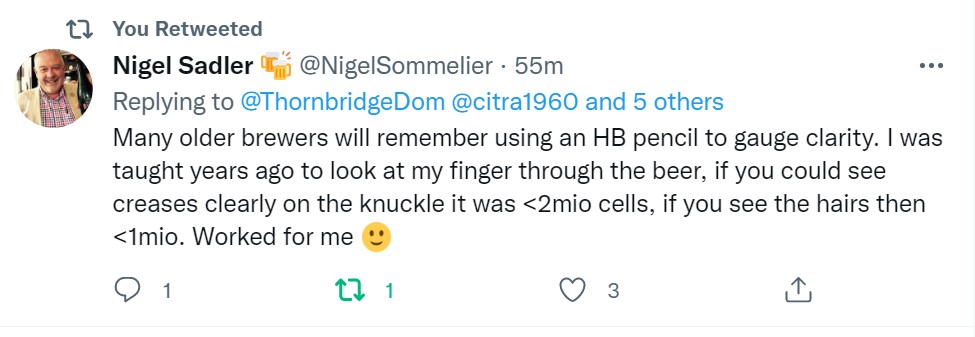 Ha-ha! I wrote bowels. If you’re not born of Scots, that might not be daily dinner table language so I apologize as I refer you in the alternative to the basso loco of Dante’s Inferno for a clearer sense of the reason for the season. But if you are Canadian of a certain age, however, there is only one true representation of the hellscape of pure evil – SCTV’s Monster Chiller Horror Theatre from around forty years ago. Wooooohooo. Scary. Lots of beer content on SCTV: Biller Hi-Lite, Moose Beer and twist off beer caps on American beer bottles. Not at all horrible is my new plan for Halloween… which I can’t believe I have not come up with before… a plan to buying candy I like, keep it to myself and eating it as I hand out the crap candy I don’t like so much to the kids. Except I don’t like candy all that much. More extreme measures will not be necessary… unlike apparently in Japan:
Ha-ha! I wrote bowels. If you’re not born of Scots, that might not be daily dinner table language so I apologize as I refer you in the alternative to the basso loco of Dante’s Inferno for a clearer sense of the reason for the season. But if you are Canadian of a certain age, however, there is only one true representation of the hellscape of pure evil – SCTV’s Monster Chiller Horror Theatre from around forty years ago. Wooooohooo. Scary. Lots of beer content on SCTV: Biller Hi-Lite, Moose Beer and twist off beer caps on American beer bottles. Not at all horrible is my new plan for Halloween… which I can’t believe I have not come up with before… a plan to buying candy I like, keep it to myself and eating it as I hand out the crap candy I don’t like so much to the kids. Except I don’t like candy all that much. More extreme measures will not be necessary… unlike apparently in Japan:
In other news, Tokyo’s Shibuya district has banned public drinking, hiring 300 private security guards and urging local stores to stop selling alcohol to ward off revelers this Halloween.
What? That’s some sort of crazy. Are nutty Halloween pub crawls a thing where you live? They seem to be a thing in Buffalo, NY, Milwaukee, Wisconsin and Lexington, Kentucky. I like it. Pack the streets. We did a similar thing in the Halifax of my 1980s youth at Halloween – but we called it Mardi Gras for some reason. Tens of thousands of us. Once I went as junk mail (my best costume ever if I am going to be honest with you) with a buddy who went as a breakfast nook – that could actually toast toast. Out there. On the street. Street toast. Class.
Anyway, have you ever seen a lede buried as deep as this one was in GBH? In a neat and tidy piece on a rebranding at the Chicago Brewseum this little bomb is dropped in the middle of paragraph ten:
Theresa McCulla, curator of the American Brewing History Initiative at the Smithsonian’s National Museum of American History, will leave that post in early November, and the role will no longer exist after her exit.
The Smithsonian program, largely funded and framed in terms of narrative by the Brewers Association’s involvement, started up in 2016. While I was disappointed in the periodic press releases highlighting things like Papazian’s paddle from the great white male hero era of craft, I trust that records and objects from throughout the over 435 years of brewing in the what are now the United States have been protected. Wonder why the Brewers Association gave up on their affiliation? A special thanks to all those beer journalists getting on that story even as I type these very words.
Speaking of endings, Stan discussed the piece in VinePair on the declining influence of US craft beer in Europe, asking if “the story totally supports an assertion that beers from America aren’t influencing change” which I get but, still, I like the arguments set out in this well thought out piece by Will Hawkes:
California-founded Stone’s failure in Europe is symbolic of a wider issue. Craft beer has made a huge splash across the Atlantic, but American breweries, for the most part, have not prospered as they might have expected — and things don’t appear to be getting better. Extrapolating from Brewers Association (BA) figures published by the organization and in Forbes, the overall craft beer volume exported to Europe declined from 78,994 barrels in 2021 to 63,755 in 2022. The reasons for this are complex, but they get to the heart of Europe’s beer market and the limitations of American craft breweries in a place where their economic power has rarely matched their cultural cachet.
TL;DR? Reasons not so much complex as just numerous… BrewDog being everywhere, other Euro brewers holding branding rights, uncompetative pricing and the botch by Stone diluting the value. Brutal line: “[at] this year’s Berlin Beer Week, Stone beers featured in a tap takeover at a pizzeria.” Perhaps relatedly, things are also not going well for brewers in New Zealand:
“I was talking to a brewer recently and he said: ‘It’s all just beer now.’ The problem with craft is it’s always been ill-defined. Does it mean small scale? Does it mean independent? Does it mean flavoursome?” Without that clear definition, the territory was ripe for major beer companies to step into – and all the big breweries have done exactly that. “You now have Lion with their Mac’s brand, DB with Monteith’s and Asahi with Boundary Road. Those are the three main ones in that area, and what they’re doing is just pumping up the flavour in those brands. They’re making great beer at a more affordable price.”
I know that this is all a bit of a downer – even though this is the “scary” season – but at least things are not as bad as they are in Rioja according to the newsletterist Jason Wilson of Everyday Drinking who includes this summary of recent findings:
I was shocked to read Tim Atkin’s piece about serious problems in Rioja — “Rioja on the Rocks” — a couple of weeks ago. I knew that Rioja had issues, but Atkin (the foremost English-language expert on Rioja) paints a dire picture of a region in crisis. As Atkin reports, the regional governments of La Rioja and the Basque Country plan to detroy 30 million liters of surplus wine to try to balance supply and demand. Another 150 million liters, unwanted by the market, is sitting in cellars. The 2023 harvest has been terrible, and grape prices are at unsustainable lows—in fact, many growers cannot sell their grapes. Reportedly, one major co-operative is on the verge of bankruptcy, two large bodegas are in administration, and Campo Viejo, Rioja’s largest winery, is allegedly up for sale. There are threats by large groups of growers and producers to leave the consortium altogether as they argue over whether to focus on quantity or quality.
Yikes! Just last year things were looking up.
Better news? How about the best big brewery marketing of the moment? Heineken making fun of its own name and using Plastic Bertrand for the soundtrack. That good. And The Brewnut has proven once again how he is the best commentator on what’s actually in the glass, illsustrated by this review of the offerings by Wicklow Wolf:
This year’s twist on the all-local ingredients spec is the inclusion of Kilmacanogue raspberries in a sour ale. Shame they didn’t have a go at spontaneously fermenting it, for extreme local character. Regardless, it’s very nice. The raspberries taste fresher and realer than they do in most raspberry beers, almost bursting on the tongue the way the fruit does. There’s no sugary, syrupy jam here, just a cleanly medium-pitched tartness, again similar to what you’d get from actual raspberries, building to a slightly puckering finish. While it’s only 4.2% ABV, I can’t see this working well as a refreshing summer beer — it’s too intense, with lots going on it. While I definitely liked it, I’m glad I waited until a dull day in October to drink it.
See that: not fawning, explains how it stands out, explains what might be done to improve. I’d buy that beer. Speaking of buying beer, David Nilsen wrote an homage to “Brouwerij Van Steenberge’s Tripel Van De Garre” in Pellicle this week and how it illustrates a few trends:
“In today’s market, imports are struggling against the locavore movement,” says Michael, noting the plethora of local options. “We have 97 breweries in the city limits [of Chicago].” Sara Levin, the package beer buyer for The Barrel House, a beloved beer bar and bottle shop in Dayton, Ohio, has been a professional beer buyer for close to a decade and says the current attitude toward Belgian beer among many American craft devotees had already begun to take shape when she started in the industry in 2014. “Before me it was a little different, but in my time I feel like Belgian beer has always been the old money craft beer,” Sara says. “It’s been the OG beer geeks who really respect the old school styles.”
That right there is one of the sadder things about the craft beer movement’s rush to chase the tale of novelty, the loss of interest in hounouring Belgian styles. Got an opinion on that? You can explain how you feel about such things if you take part in this week’s study on the habits of craft beer and real ale drinkers? Do you have habits? They want to study you. In a similar note, Gary came across a study of real ale drinking in England from 1866… with some very and sadly familiar themes:
Less than one-half of it is drunk in perfection, or at its best condition, the larger percentage becoming more or less flat, hard [tart], and unpalatable, or even sour before it is consumed. From the day of the tapping of the cask, with the gradual entrance of atmospheric air, the liqour undergoes progressive deterioration, first becoming flat and unpalatable, from the loss of its carbonic acid, and then sour from having its spirit converted in acetic acid by the absorption of oxygen. In fact, day by day, as the palate unplesantly detects, it may be said to advance one step further on the road to vinegar.
Yik. Too much OG old school right there. And sorta samesies [h/t] at the blog run by Triskele Heritage, an archaeological consultancy, there was a sweet disassembling of the claim made by an Irish pub as to its status as the world’s oldest tavern:
The problem here is that the fabric of the building is claimed to date to the ninth century, and this is repeated from one website to another, but no archival or archaeological evidence is ever offered as the root source of the information. Instead, the listed entry for Sean’s Bar on the National Inventory of Architectural Heritage… notes that the current standing building was constructed c 1725 as a coaching inn which was known as The Three Blackamoors Heads by 1738. The record goes onto confirm that renovations were indeed carried out c 1970 but, instead of finding ““wattle and wicker” dating back to the ninth century”, the walls in question were dated to the seventeenth century. That is a potential exaggeration of at least seven centuries.
Speaking of even more not quite right, perhaps that green bottle of Tsingtao isn’t just skunky:
In the clip which appeared online on Thursday, a worker, dressed in uniform with a helmet on, can be seen climbing over a high wall and into the container before urinating inside it. The location tag of the clip reads “Tsingtao beer No.3 factory”, local news outlet The Paper reported on Friday. Business outlet “National Business Daily” later cited an internal source as saying both the person who took the video and the person appearing in it were not direct employees of the company… Shares in Tsingtao Brewery fell sharply when the Shanghai Stock Exchange opened on Monday morning but were trading broadly flat by the afternoon.
Boo-tastic. Now we have pee in the stuff. In other scary health news, the Time of Londinium shared a story on the problems with a certain sort of stress drinking and had this very interesting fact:
A recent study… found that women with high levels of cardiorespiratory fitness are between 1.5 to 2 times as likely to drink moderately or heavily as those who are sedentary. Charlotte considered herself to be healthy. “I’d go running on Saturday at 8am with my friends after drinking two bottles of wine on Friday. Parker tried all the right things to manage stress. “I went to a meditation teacher, I was looking at my diet, I ran a lot” — everything except quit drinking.”
That is interesting. Fact filled and interesting. And scary.
Enough!!! I leave you there for this week. As per always and forever, you can check out the many ways to find good reading about beer and similar stuff via any number of social media and other forms of comms connections. I have yet another update on the rankings. TweX is now really starting to drop in the standings. I am deleting follows there more and more in favour of mirroring accounts set up by favourite voices elsewhere. Now, for me Facebook is clearly first (given especially as it is focused on my 300 closest friends and family) then we have BlueSky (74) rising up to sit in a tie with Mastodon (899) then the seemingly doomed trashy Twex (4,344) hovering somewhere above or around Instagram (167) with Threads (41) and Substack Notes (1) really dragging – and that deservedly dormant Patreon presence of mine just sitting there. Seven apps plus this my blog! That makes sense. I may be multi and legion and all that but I do have priorities and seem to be keeping them in a proper row. All in all, I still am rooting for the voices on the elephant-like Mastodon, like these ones just below discussing beer, even though it is #Gardening Mastodon that really wins:
Alan McLeod | A Good Beer Blog (… me…)
Stan Hieronymus | The Man!
Boak & Bailey | The B² experience
Curmudgeon Ale Works | Jonathon is Brewing
Katie Mather | Shiny Biscuit and Corto
David Jesudason | “Desi Pubs” (2023) author
BeoirFest | They say “Let’s Talk Beer”
Ron Pattinson | The RonAlongAThon Himself
Al Reece AKA Velky Al | Fuggled
Jennifer Jordan | US hops historian
Andreas Krennmair | Vienna beer and lager historian
Beer Ladies Podcast | Lisa Grimm and colleagues
The Bar Towel | Toronto’s chat zone for beer lovers
Chicago Beer Society | Folk in Chicago getting social over beer
Jay Brooks | Brookston Beer Bulletin
Joe Stange | Belgian beer expert, beer magazine editor
Cider Bar | Barry makes Kertelreiter cider
Laura Hadland | CAMRA historian and beer writer
Brian Alberts | US beer historian
Jon Abernathy | The Beer Site
Maureen Ogle | US Beer Historian
Lars Garshol | Norwegian Beer Historian and Kveik Hunter
James Beeson | Beeson on Beer
Carla Jean | MAINER!!!
Thandi Guilherme | Beer Ladies Podcast Co-host
Lisa Grimm | Beer Ladies Podcast Co-host
Roy of Quare Swally | Beery ramblings from Northern Ireland
Rob Talksbeer | Podcaster and Youtuber
Anthony Gladman | UK Drinks Writer
Jeff Alworth | Manna Of Beervana
Northwest Beer Guide | Fairly self explanatory… but not NW Latvia…
Evan Rail | Prague based GBH editor, freelance writer, NYT etc.
Todd Alström | 50% of the Alströms
Jacob Berg | Beer talking librarian
Anyone else? And, yes, we also check the blogs, podcasts (barely!) and even newsletters to stay on top of things including the proud and public and certainly more weekly recommendations from Boak and Bailey every Saturday and Stan at his spot on those Mondays! Here’s a new newsletter recommendation: BeerCrunchers. And get your emailed issue of Episodes of my Pub Life by David Jesudason on many Fridays. And Phil Mellows is at the BritishBeerBreaks. Once a month, Will Hawkes issues his London Beer City newsletter and do sign up for Katie’s now much more occassional but always wonderful newsletter, The Gulp, too. Ben’s Beer and Badword is back with all the sweary Mary he can think of! And check out the Atlantic Canada Beer Blog‘s weekly roundup. There is new reading at The Glass. Any more? Yes! Check to see the highly recommended Beer Ladies Podcast. That’s quite good. And the long standing Beervana podcast . There is the Boys Are From Märzen podcast too and Ontario’s own A Quick Beer. There is more from DaftAboutCraft‘s podcast, too. All About Beer has introduced a podcast… but also seems to be losing steam. And there’s also The Perfect Pour. Plus follow the venerable Full Pint podcast. And the Craft Beer Channel on Youtube and remember BeerEdge, too, and The Moon Under Water… if you have $10 a month for this sort of thing… I don’t. Pete Brown’s costs a fifth of that. There was also the Beer O’clock Show but that was gone after a ten year run but returned renewed and here is the link!
















